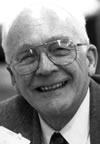Elias Snitzer
About Optica
In Memoriam: Elias Snitzer,
21 May 2012
OSA Mourns the Loss of Elias Snitzer, Fiber Optics Pioneer, 1925-2012

Elias Snitzer, an OSA Fellow Emeritus known for his pioneering contributions to fiber optics technology, died 21 May 2012 in Boston, Massachusetts, USA. He was 87. Snitzer was a Professor Emeritus of Ceramic and Materials Engineering at Rutgers University in New Jersey, USA.
Known as the “Father of the Glass Laser,” Snitzer demonstrated the first glass laser in 1961, a year after Maiman reported the first crystalline laser based on ruby.
Snitzer was born in Lynn, Massachusetts, in 1925. He graduated from Tufts University in 1945 with a B.S. in Electrical Engineering and received his M.A. (1950) and Ph.D. (1953) in Physics from the University of Chicago, where he took classes from Enrico Fermi. From 1954 to 1956, Snitzer worked at Honeywell Industrial Instruments Division on thermal detector technology.
He began teaching at the Lowell (Massachusetts) Technological Institute in 1956, but his career stalled in 1958 when he was called to testify before the House Un-American Activities Committee (HUAC), an investigative committee of the United States House of Representatives. Snitzer later recalled that “(I) was subpoenaed to appear before the House Un-American Activities Committee as a consequence of the fact that I had been very heavily involved in left-wing politics as a student at the University of Chicago... I was at Lowell Tech at the time that I was subpoenaed... I (subsequently) lost my job. That case was taken up by the AAUP and it was finally settled (in my favor) some years later... It was a very difficult time because my wife was pregnant with our fifth child.”
Snitzer was hired by American Optical (AO), a company that was moving away from its established product line relating to ophthalmic instruments, microscopes and ophthalmic products, into new fields related to electro optics. At AO, Snitzer began his work in optical fibers and lasers. In 1961, he published in the Journal of the Optical Society of America a comprehensive theoretical description of single mode fibers, fiber with a core so small it could carry light with only one wave-guide mode. Shortly thereafter, he reported the first operation of a neodymium glass (Nd:glass) laser. He demonstrated the first optical fiber laser and the first fiber amplifier.
Snitzer remained at AO as director of corporate research until 1977. He then moved to United Technologies Research Center (UTRC), where he was responsible for the initiation of the ultra-violet side writing of fiber Bragg grating programs. From 1984 to 1988 he worked at Polaroid Corporation, where he directed research and development of fiber and integrated optics programs for communication, sensors, and photographic instrumentation. At Polaroid, Snitzer and his team first demonstrated the double clad fiber laser in 1988. In 1989, he joined the Ceramic Science and Engineering faculty of Rutgers University, where he continued to teach and research fiber laser amplifiers, glass, and fiber Bragg Gratings until his retirement in 2001. The major accomplishments of his time at Rutgers were the development of the Praseodymium fluoride glass fiber laser amplifier and the development of the mask fabrication of fiber Bragg gratings. In 1992, along with one of his students, Snitzer established Photo Refractive Enterprises, Inc., a company to commercially develop mask fabrication of fiber Bragg Gratings.
An OSA member since 1961, Snitzer was named a Fellow in 1964. He received numerous awards and honors, including the OSA Charles Hard Townes Award (1991) and John Tyndall Award (1994); the IEEE Photonics Society Quantum Electronics Award (1979); the Otto Schott Research Award (1999); and the Rank Prize for the invention of the cladding pumped fiber lasers (2000). He was named a Life Fellow of the IEEE, and he was elected to the National Academy of Engineering in 1979 for the invention of the glass laser and the fiber-optics laser. The American Ceramic Society honored him with the Morey Award for glass science (1971) and as the inaugural recipient of the Stookey Award, given for a lifetime of innovative exploratory work or “noteworthy contributions of outstanding research on new materials, phenomena, or processes involving glass, that have commercial significance or the potential for commercial impact.”
While the majority of his career was spent in industry, Snitzer had a significant impact on his students while at Rutgers. He had a unique ability to synthesize concepts from different fields of physics, chemistry, and materials and distill them into simple concepts with practical applications. John Bellato, a former student, recalled that Snitzer could take complex equations and theories and quickly approximate solutions (“ ‘pi is 3... squared is 9,’ and we quickly had an order-of-magnitude estimate that I could go back into the lab and test.”).
Snitzer enjoyed spending time with his family. He was an avid tennis player and loved the ocean. He is survived by five children, Sandra, Barbara, Peter, Helen and Louis, 10 grandchildren and 5 great-grandchildren. His wife, Dr. Shirley (Wood) Snitzer, passed away in April 2009.
Funeral services will be held on 26 May 2012 in Wellesley Hills, Massachusetts.
If you would like to make a memorial donation to the OSA Foundation in honor of Elias Snitzer, please visit www.osa-foundation.org/give.
